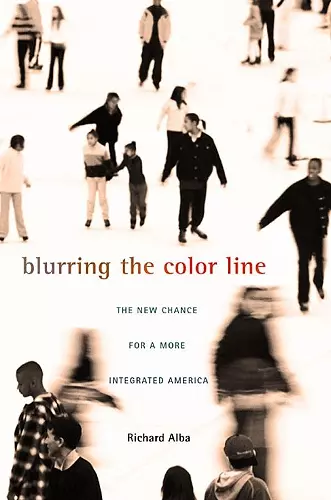Blurring the Color Line
The New Chance for a More Integrated America
Format:Paperback
Publisher:Harvard University Press
Published:4th Apr '12
Currently unavailable, and unfortunately no date known when it will be back

Blurring the Color Line offers a primer on how to make assimilation happen in the 21st century. -- Douglas S. Massey, Princeton University, editor of New Faces in New Places: The New Geography of American Immigration Blurring the Color Line has the potential to be an instant classic. It demonstrates through a rigorous analysis of demographic, economic, and social data that the successful integration of American minority groups is very possible in the coming decades. -- Mary C. Waters, Harvard University, co-author of Inheriting the City: The Children of Immigrants Come of Age(Harvard)
Alba argues that the social cleavages separating Americans into distinct, unequal ethno-racial groups could narrow dramatically in the coming decades. In Blurring the Color Line, Alba explores a future in which socially mobile minorities could blur stark boundaries and gain much more control over the social expression of racial differences.
Richard Alba argues that the social cleavages that separate Americans into distinct, unequal ethno-racial groups could narrow dramatically in the coming decades. During the mid-twentieth century, the dominant position of the United States in the postwar world economy led to a rapid expansion of education and labor opportunities. As a result of their newfound access to training and jobs, many ethnic and religious outsiders, among them Jews and Italians, finally gained full acceptance as members of the mainstream. Alba proposes that this large-scale assimilation of white ethnics was a result of “non-zero-sum mobility,” which he defines as the social ascent of members of disadvantaged groups that can take place without affecting the life chances of those who are already members of the established majority.
Alba shows that non-zero-sum mobility could play out positively in the future as the baby-boom generation retires, opening up the higher rungs of the labor market. Because of the changing demography of the country, many fewer whites will be coming of age than will be retiring. Hence, the opportunity exists for members of other groups to move up. However, Alba cautions, this demographic shift will only benefit disadvantaged American minorities if they are provided with access to education and training. In Blurring the Color Line, Alba explores a future in which socially mobile minorities could blur stark boundaries and gain much more control over the social expression of racial differences.
Blurring the Color Line offers a primer on how to make assimilation happen in the 21st century. -- Douglas S. Massey, Princeton University, editor of New Faces in New Places: The New Geography of American Immigration
Blurring the Color Line has the potential to be an instant classic. It demonstrates through a rigorous analysis of demographic, economic, and social data that the successful integration of American minority groups is very possible in the coming decades. -- Mary C. Waters, Harvard University, co-author of Inheriting the City: The Children of Immigrants Come of Age(Harvard)
When it comes to understanding racial change and integration in the United States, Richard Alba is a groundbreaker...Alba's detailed narrative shows how public education can make the difference between significant, rapid social change with respect to race, and slow, more piecemeal blurring. One might read this book as another argument for why public education needs to be ramped up, especially in urban areas, but the implications, I believe, go further...Blurring the Color Line presents an impressive amount of evidence to support Alba's sophisticated arguments, and he presents all sides of the complex arguments of the book. Impressive in its lucidity, in addition to quantitative analysis the book is rich with details about complex sociological research related to the topics of the book...A theory as overarching as Alba's is impressive in its detail, its reach, and its ability to explain the past and hypothesize about the future. -- Natasha Kumar Warikoo * Teachers College Record *
Blurring the Color Line is a groundbreaking, original, and important work which greatly advances and broadens the debate on the future makeup of American society. In doing so, it also marshals a great deal of demographic and statistical evidence to back up the incisive arguments made by the author...Blurring the Color Line is a brilliant and lucid analysis with very important implications that need to be carefully thought through. As such, it is mandatory reading for all those interested in policy analysis, and especially for leaders responsible for shaping and implementing it. -- William Helmreich * Society *
This is a gutsy book, one that few scholars would have dared to write and one that even fewer are sufficiently knowledgeable to undertake. Although critics can nitpick, Blurring the Color Line is essential reading for scholars, students, activists, and pundits in the field of race and ethnicity, and anyone interested in the promise of social science to inform the policy agenda. -- Charles Hirschman * Population and Development Review *
- Nominated for Anisfield-Wolf Book Awards 2010
- Nominated for Otis Dudley Duncan Award 2010
- Nominated for Society for the Study of Social Problems C. Wright Mills Award 2009
- Nominated for Distinguished Contribution to Scholarship Award - Race, Gender, and Class 2011
ISBN: 9780674064706
Dimensions: unknown
Weight: unknown
320 pages